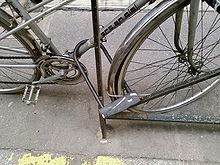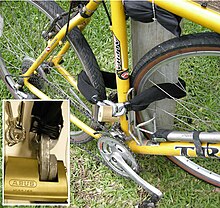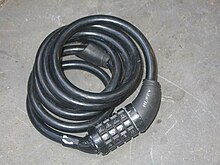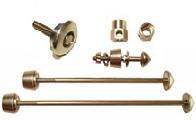This is an old revision of this page, as edited by Andrewdavidnolan (talk | contribs) at 18:39, 22 May 2013 (→References). The present address (URL) is a permanent link to this revision, which may differ significantly from the current revision.
Revision as of 18:39, 22 May 2013 by Andrewdavidnolan (talk | contribs) (→References)(diff) ← Previous revision | Latest revision (diff) | Newer revision → (diff)| This article needs additional citations for verification. Please help improve this article by adding citations to reliable sources. Unsourced material may be challenged and removed. Find sources: "Bicycle lock" – news · newspapers · books · scholar · JSTOR (April 2008) (Learn how and when to remove this message) |
| This article possibly contains original research. Please improve it by verifying the claims made and adding inline citations. Statements consisting only of original research should be removed. (November 2012) (Learn how and when to remove this message) |

A bicycle lock is a security device used to prevent bicycle theft, generally by fastening the bicycle to a fixed object, e.g., a bike rack.
An inherent challenge to bicycle theft prevention is the detatchability of the wheels from the frame. Unless both wheels and frame are secured, wheels can be removed separately. An optimal locking method will secure the frame as well as both wheels — either to a fixed object or to each other.
Locking devices vary in size and security; the most secure tending to be the largest, heaviest and least portable. Lesser equipment is used to deter attempts by less skilled and determined thieves. Thus like other security equipment, bicycle locks must compromise between security, portability and cost. Some are made of particularly expensive materials chosen for their acceptable strength and low density.
An alternate defense is the provision of bicycle lockers in which the whole bicycle is locked. This also safeguards equipment such as lamps, tools, spare tubes etc., against all but the most industrious thief, or one equipped with heavy equipment or power tools. Bicycle lockers, however, generally take up much more space than exposed bicycle racks, limiting potential storage capacity in a given space. An alternative is a card-access bike cage such as is present at Alewife station in Cambridge, Massachusetts. In addition to a bike lock, bike registry can further assist in providing recovery in the event of theft.
Test standards that rate the effective security of bicycle locks are provided by Thatcham and Sold Secure in the United Kingdom, ART in the Netherlands, SSF in Sweden, and VDS in Germany. Tests carried out by the Cyclists' Touring Club showed that all of the locks under test could be broken in less than 42 seconds using either bolt croppers for a cable/chain or a bottle jack for D-locks.
U-locks and D-locks

A U-lock is a rigid metal ring in the shape of the letter U. The U part of the lock attaches to a crossbar section, and for this reason they are also called D-locks. To lock the bicycle, one locks it physically to some other object, such as a bike rack securely in the ground, parking meter or a flagpole. Merely locking the bike frame to the wheel is not recommended because, although it cannot be rolled away, the entire bicycle can still be lifted and carried away.

U-locks are more secure than most other kinds of locking mechanism because they are more resistant to cutting with high-leverage hand tools such as bolt cutters. However, they are still vulnerable to some types of exploit. For instance, if there is enough space for a thief to fit a jack into the U, the jack can produce enough leverage to break the lock. Another common brute force method to break open U-locks is to use a long length (perhaps 2 meter) of pipe to twist the lock open. Like all locks, U-Locks are vulnerable to power tools. Certain Tubular pin tumbler lock U-Locks can be easily picked by thieves using a common Bic pen, so cyclists should avoid these models.

A very similar type of lock, often referred to as an O-lock, or a "bike club," is a retracting shackle lock. This lock may be more protective as it does not leave space for thieves to insert tools like a car jack which would burst a normal u-lock.
Chain
A chain lock is a chain with a lock. It often has a key or a combination lock attached to it. A long enough chain can pass through both wheels, the frame and attach the bicycle to an immovable object. Because of their inherent flexibility, chains are easier to secure around tricky-shaped objects than D-locks.
Chains vary widely in their security level. If the chain is bought from a hardware store, it is most likely made from basic iron or steel and can easily be cut with a relatively inexpensive pair of bolt cutters. Chains specifically designed for locking bicycles are available. These case hardened security chains have links shaped in a manner that deters bolt cutters, such as with a hexagonal or trapezoidal cross-section and are difficult to cut with hand tools, but easily defeated with power tools.
A chain is only as strong as its weakest link, which may be the lock itself. Although a cheap keyed or combination lock may be an appropriate match for a hardware store chain, a case-hardened security chain necessitates a specialized lock such as a monobloc padlock or mini u-lock.
Compared to other locks, chains tend to be the heaviest solution, especially in the case of long and/or tough chains.
Cable locks



Cable locks are in many ways similar to chain locks. Cable locks often come with the locking mechanism already permanently integrated. Otherwise, a length of cable with loops on both ends can also be used.
The main advantage of cable locks over chains is the ease of transporting them. Many cable locks are made of spring cable that automatically coils itself when released. Even a straight cable can be coiled by the user into a more manageable shape than a chain.
Simple cable locks, however, are only sufficient for use in low-risk areas. Even the largest diameter unprotected cable can be quickly cut with bolt cutters. More robust cable locks such as the one shown on the right have overlapping steel jackets threaded over the cable. This can make it more difficult to cut the central cable.
Many cyclists use a long cable to secure bicycle components (such as the wheels or seat) in conjunction with a U-lock or padlock to secure the frame. Special strong cables are available which are made with a loop at each end continuous with the cable, which enable linking with a locking device.
Also, a common defect with cables containing combination locks allows the combination to be deciphered. This is done by peering into the grooves between the disks whilst cycling through the individual numbers on each disk, one at a time.
Wheel lock

Also called an O-lock or ring-lock, this is a low security mechanism mounted on the frame that immobilizes the rear wheel by moving a steel bolt through the spokes to prevent motion. It uses a straight or circular bolt which extends from the housing. This type of lock is common in Scandinavia, the Netherlands, China, India and Japan.
An O-lock prevents riding the bicycle but does not, by itself, secure the bicycle to a stationary object. This type of lock is effective and convenient for securing a bicycle against opportunistic theft, when the bike is left unattended momentarily. It forces the thief to carry the bicycle.
The O-lock also conveniently secures the rear wheel: only locking the frame is needed, to secure both the frame and the rear wheel. Some models have an optional cable or chain that plugs into the body of the lock to enable the bicycle to be secured as well.
Locking skewers

Locking skewers replace the existing quick release skewers on a bicycle's wheels and seatpost clamp (quick release skewers enable removal without tools). This reduces the need to lock these parts of the bike since now their removal requires tools. One type of locking skewer uses the same design as a normal quick release skewer, except after clamping the skewer the (keyed) handle may be removed.
Another type of locking skewer uses a uniquely shaped nut that can only be turned using the matching socket/key, which is typically a wrench-like tool that is small enough to fit on a keychain. Though expensive, locking skewers provide additional security and convenience. Locking wheels with an additional U-Lock or removing the front wheel and locking it to the frame and rear wheel would provide the highest security. A disadvantage is that if the owner loses the special tool then they will not be able to undo the skewer, and will need to obtain a spare tool from the manufacturer. The same type of uniquely shaped nut used for the locking skewer can also be found for suspension forks, V-brakes, and solid-axle wheels in addition to regular wheels and seatposts. Manufacturers such as Pitlock and Pinhead offer services to supply additional lock nuts to an existing key number registered by the owner.
Even though a determined thief could eventually defeat the skewer's lock nut by using a power tool, e.g. by grinding a screwdriver slot into it or simply cutting it off, locking skewers provide convenient protection against theft of bicycle parts in areas where locked bicycles should not be left unattended for long periods of time. The highest quality products currently found on the market use stainless steel to avoid a number of disadvantages presented by carbon steel and aluminum including corrosion (rust) and damage to the locking mechanism's unique key indentations caused by key slip-out.
Less expensive options include replacing standard quick release skewers with skewers that need a standard hex key to be opened. Despite hex keys not being very rare, this method still guards the bicycle from casual opportunists, needing the less common tool and more time to be removed. Pentagonal key skewers exist which bring some of the benefit of a locking skewer at a lower cost. Quicker and cheaper yet, and only effective against thieves unequipped with even a screwdriver, quick-release levers can be tied down by a common hose clamp.
Another cost effective approach to wheel security is to replace the front and rear quick-release skewers with a long stud, such as manufactured by BikeRegistry. This approach secures one end of the stud with a permanently attached acorn nut; the other end is secured by double nylon-insert nuts and washers which allow the entire assembly to spin freely if wheel removal is attempted. (This can thwart someone carrying a single wrench, but is trivially defeated by using a wrench on each end.)
Wheels are also commonly secured by use of a wheel tether, basically a flexible steel cable with a noose swaged on either end. This type cable does not require its own lock. It is secured by the main security device, which may be a security chain, u-lock or even another cable device.
Standards and tests
Test standards that rate the effective security of bicycle locks are provided by Thatcham and Sold Secure in the United Kingdom, Stichting ART in the Netherlands, SFF in Sweden (see SSF - article in Swedish), and VDS in Germany (see VDS - Article in German).
Sold Secure was set up by the Northumbria Police and Essex Police in 1992 with the backing of the Home Office. It is now a not-for-profit corporation owned by the Master Locksmiths Association. Each model of lock tested requires an initial test and ongoing annual audit. In the U.K., a Sold Secure or Thatcham certified lock is usually required in order to insure a bicycle or motorcycle against theft. Sold Secure certify locks with either a Bronze, Silver or Gold rating, corresponding to an attack resistance of 1, 3 and 5 minutes with various tools.
Tests carried out on behalf of Cycle magazine showed that all of the bicycle locks tested, which had a variety of certifications from Sold Secure, Thatcham, and ART, could be broken in less than 42 seconds. Cables and chains were breached using either small cable cutters or 36" bolt croppers, and D-locks were breached using a stubby bottle jack. Of the locks tested, five had a Sold Secure Gold rating, varying in price from £25 to £100. Two of these Gold rated locks withstood only 10 seconds of attack.
Tests carried out by Almax Security Chains Ltd. and supervised by Readers Digest have shown that most Thatcham and Sold Secure approved motorbike chains can be cut using ordinary bolt croppers. A video of the tests is available online. In similar tests carried out by Motor Cycle News magazine, Almax chains were the only ones to survive a bolt cropping attack. Almax produce a shorter 0.7m version of their chain for bicycles. The tests included chains from Squire Locks, Luma, ABUS, Oxford Products and Kryptonite.
The Dutch consumer news show Kassa 3 published a four-minute show in which a former bicycle thief removed eight consumer-grade locks from a bike in times ranging from 10 to a maximum of 84 seconds. The locks included those from manufacturers ABUS, Hema and Halfords.
See also
- Bicycle locker
- Bicycle parking
- Bicycle stand - also known as bicycle rack
- Bicycle tree
- Bicycle transportation engineering
- Bike registry
- Wheel clamp
References
- ^ Carlton Reid (Feb-March 2008). "Cycle Magazine: Gone in 42 seconds!". Cyclists' Touring Club. pp. 42–46.
{{cite news}}: Check date values in:|date=(help) - ^ "Lock it or lose it". QuickRelease.TV. 2008-02-14.
- "Sold Secure". Squire Security.
- "Lock breaching table". QuickRelease.TV. 2008-02-14.
- "Various Sold Secure and Thatcham chains chopped". Almax Security Chains Ltd. 2006-11-24.
- "MCN chain test videos". Motor Cycle News. 2006-02-01.
- "Almax FAQ". Almax Security Chains Ltd.
- "Almax Series III". Almax Security Chains Ltd.
- Jalal Bouzamour. "Kassa3 - 'how to steal a bike'". Kassa (television program).
9. Lock & Security Chain SelectionElite security Guides
10. Sold Secure - Testing Explained Elite security Guides